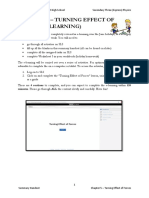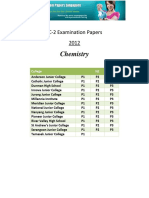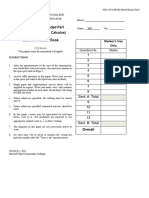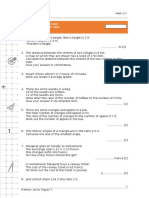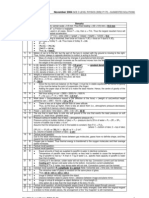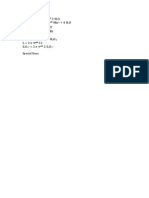H2 Physics Exam Set E P2
H2 Physics Exam Set E P2
Uploaded by
Ng Jia ChengCopyright:
Available Formats
H2 Physics Exam Set E P2
H2 Physics Exam Set E P2
Uploaded by
Ng Jia ChengOriginal Description:
Copyright
Available Formats
Share this document
Did you find this document useful?
Is this content inappropriate?
Copyright:
Available Formats
H2 Physics Exam Set E P2
H2 Physics Exam Set E P2
Uploaded by
Ng Jia ChengCopyright:
Available Formats
H2 Physics Set E Paper 2
www.ThePhysicsCafe.com
1 | P a g e
H2 PHYSICS
Exam papers with worked solutions
(Selected from Top JC)
SET E
PAPER 2
Compiled by
THE PHYSICS CAFE
H2 Physics Set E Paper 2
www.ThePhysicsCafe.com
2 | P a g e
READ THESE INSTRUCTIONS FIRST
Write your name, class and index number and on all the work you hand in.
Write in dark blue or black pen.
You may use a soft pencil for any diagrams, graphs or rough workings.
Do not use staples, paper clips, highlighters, glue or correction fluid.
Answer all questions.
At the end of the examination, fasten all your work securely together.
The number of marks is given in brackets [ ] at the end of each question or part question.
T
h
e
P
h
y
s
i
c
s
C
a
f
e
H2 Physics Set E Paper 2
www.ThePhysicsCafe.com
3 | P a g e
DATA AND FORMULAE
Data
speed of light in free space, c = 3.00 x 10
8
m s
-1
permeability of free space,
o
= 4t x 10
-7
H m
-1
permittivity of free space,
c
o
= 8.85 x 10
-12
F m
-1
~ (1/(36t)) x 10
-9
F m
-1
elementary charge, e = 1.60 x 10
-19
C
the Planck constant, h = 6.63 x 10
-34
J s
unified atomic mass constant, u = 1.66 x 10
-27
kg
rest mass of electron, m
e
= 9.11 x 10
-31
kg
rest mass of proton, m
p
= 1.67 x 10
-27
kg
molar gas constant, R = 8.31 J K
-1
mol
-1
the Avogadro constant, N
A
= 6.02 x 10
23
mol
-1
the Boltzmann constant, k = 1.38 x 10
-23
J K
-1
gravitational constant, G = 6.67 x 10
-11
N m
2
kg
-2
acceleration of free fall, g = 9.81 m s
-2
Formulae
uniformly accelerated motion, s = ut + at
2
v
2
= u
2
+ 2as
work done on/by a gas, W = pAV
Average kinetic energy of a molecule of an ideal gas U = kT
2
3
hydrostatic pressure, p = gh
gravitational potential, u =
GM
r
displacement of particle in s.h.m. x = x
o
sin t
velocity of particle in s.h.m. v = v
o
cos t
( )
2 2
o
x x e =
resistors in series, R = R
1
+ R
2
+
resistors in parallel, 1/R = 1/R
1
+ 1/R
2
+
electric potential V = Q/4tc
o
r
alternating current/voltage, x = x
o
sinet
transmission coefficient T exp (-2kd)
where k =
( )
2
2
8 m U E
h
t
radioactive decay, x = x
o
exp(-t)
decay constant,
=
0.693
t
H2 Physics Set E Paper 2
www.ThePhysicsCafe.com
4 | P a g e
1 (a) The kilogram and the metre are base units. Name two other base units.
[1]
(b)
The capacitance of a conductor C is the amount of charge Q required to
cause a unit change in its potential difference (p.d.), V.
Potential difference is defined as the electrical energy per unit charge
converted to non-electrical energy.
The formula is C = Q / V
(c) (i) Express the unit for capacitance in base units.
Base units = ..[2]
(ii) A student conducted an experiment to find the capacitance of a
conductor. He recorded the following values:
Current passing through the conductor = 1.0 A 10%
Time taken during the charging process = (0.4 0.1) s
Potential difference across the conductor = (2.0 0.2) V
Calculate, with its actual uncertainty, the value of the capacitance of
the conductor.
Capacitance = ..
[3]
For Examiners
Use
T
h
e
P
h
y
s
i
c
s
C
a
f
e
H2 Physics Set E Paper 2
www.ThePhysicsCafe.com
5 | P a g e
2 A ski jumper lands 96 m from his take off point as shown in Figure 2.1 below. The
slope is at an angle of 45 and the jumper is in the air for 4.3 s.
Assuming that air resistance is negligible, find
(a) the horizontal distance traveled
Distance = m [1]
(b) the horizontal component of the velocity at take off
Velocity = m s
-1
[1]
(c) the vertical distance from take off to landing
Distance = m [1]
(d) the vertical component of the take off velocity
For Examiners
Use
Fig. 2.1
Ski jumper
H2 Physics Set E Paper 2
www.ThePhysicsCafe.com
6 | P a g e
Velocity = m s
-1
[2]
(e)
the angle of take off, u
u = .
o
[1]
(f) the speed of take off.
Speed = . m s
-1
[2]
(g) State the effect on the maximum horizontal distance travelled by the ski
jumper if air resistance is not negligible.
.[1
]
3 A student did the following experiments. The density of water is 1.0 x 10
3
kg m
-3
.
(a) He finds that a rock whose mass is 100 g has an apparent mass of 82 g
when submerged in water. Find the density of the rock.
Density = . kg m
-3
[3]
(b) He puts an ice-cube of mass 120 g in a glass of water. The ice-cube floats.
Determine
(i) the upthrust on the ice-cube,
For Examiners
Use
T
h
e
P
h
y
s
i
c
s
C
a
f
e
H2 Physics Set E Paper 2
www.ThePhysicsCafe.com
7 | P a g e
Upthrust = . N [1]
(ii) the volume of the water displaced by the ice-cube.
V = .. m
3
[1]
(c) He observes that in (b), when the ice-cube floating in a jug of water melts,
there is no change in the level of the water. Explain.
..
.
[2]
4 (a) A centrifuge rotor, in Fig. 4.1 (not drawn to scale), rotates at 3 000 r.p.m.
(revolutions per minute). The top of a test tube (perpendicular to the rotation
axis) is 6.0 cm, and the bottom of the tube is 10.0 cm, from the axis of
rotation. A test tube of blood is secured in the centrifuge. It can be assumed
that the test tube of blood undergoes uniform circular motion.
Blood cells and plasma are separated and found at the bottom and top of the
tube respectively after one minute in the centrifuge.
(i) Show that the frequency of the rotation is 50 Hz.
Frequency = .. Hz [1]
(ii) Calculate the acceleration at the bottom of the tube.
For Examiners
Use
(Plan view of centrifuge)
Fig. 4.1
6.0 cm
10.0 cm
Axis of rotation
Test tube
H2 Physics Set E Paper 2
www.ThePhysicsCafe.com
8 | P a g e
Acceleration = m s
-2
[2]
(iii) Use the appropriate Newtons Laws of motion to explain why the
heavier blood cells will be found at the bottom of the tube.
.
.
.. [2]
(b) The centripetal acceleration, a, of a body undergoing a uniform circular
motion of radius r can be expressed as either (1)
r
v
a
2
= or (2) a = r e
2
,
where v and e are linear and angular speeds of the body respectively.
For a uniform circular motion of constant period, student A thinks that a
decreases with r according to equation (1), while student B argues that a
increases with r according to equation (2).
Explain which students argument is correct.
[2]
For Examiners
Use
T
h
e
P
h
y
s
i
c
s
C
a
f
e
H2 Physics Set E Paper 2
www.ThePhysicsCafe.com
9 | P a g e
5 (a) Explain the meaning of coherence in relation to the superposition of the two
waves.
.[1]
(b) The apparatus illustrated in Fig. 5.1 (not drawn to scale) is used to
demonstrate two-source interference using light.
The separation of the two slits in the double slit arrangement is a and the
interference fringes are viewed on a screen at a distance D from the double
slit. When light of wavelength is incident on the double slit, the separation
of the bright fringes on the screen is x.
(i) Write down an expression relating , a, D and x. [1]
(ii) Light of wavelength 500 nm is used in an experiment. The distance
between the double slit and the screen is 1.0 m.
It is observed on screen that the first to the last of the 12 bright fringes
span a distance of 3.0 cm. Calculate the separation of the two slits.
Slit separation = mm [2]
(iii) Describe the effect, if any, on the separation and on the maximum
brightness of the fringes in (ii) when the following changes are made.
[3]
1. Red light is used instead with half the original amplitude of the light
used in (ii), while keeping a and D constant.
.
Light
wavelength
D
a
Double slit
Fig. 5.1
For Examiners
Use
H2 Physics Set E Paper 2
www.ThePhysicsCafe.com
10 | P a g e
.
.
2. The width of each slit is increased, while keeping a, and D
constant.
....
.
.
6 (a) A radioactive source has an initial number of N undecayed atoms and its
half-life is T. Sketch on the axis in Fig. 6.1 below a graph which shows
qualitatively how the number of undecayed atoms varies with time. Indicate
on your sketch for at least 2 half-lives. [2]
(b) For a particular radioactive source, the decay constant is 1.8 x 10
-6
s
-1
, and
N = 3.7 x 10
21
.
(i) Calculate the half-life of the source.
Half-life = .. s [1]
(ii) Calculate the number of undecayed atoms after 30 days.
Number = .. [2]
(iii) Calculate the activity of the source after 30 days.
Activity = s
-1
. [2]
time
Number of
undecayed atoms
For Examiners
Use
Fig. 6.1
T
h
e
P
h
y
s
i
c
s
C
a
f
e
H2 Physics Set E Paper 2
www.ThePhysicsCafe.com
11 | P a g e
7 If a conducting liquid flows through a magnetic field, the conditions exist for an e.m.f.
to be set up across the liquid. The principle is used in electromagnet flow meters to
measure the rate of flow of liquid along a pipe. A diagram of this type of flowmeter is
given in Fig. 7.1. As the liquid flows through the tube it cuts through the magnetic
field set up by the field winding coils, causing an e.m.f. E
1
to be induced. The e.m.f.
is sensed by two electrodes X and Y which are opposite each other and in contact
with the liquid at right angle to the axis of the magnetic field.
In addition, there is a flux sensing coil which gives an output E
2
proportional to the
magnetic flux density.
(a) Explain why the pipe, in the vicinity of the electrodes, have to be non-
conducting.
..
.
.[1]
(b)
(i) Show that
1
E kvB = where k is a constant. [2]
Fig. 7.1
For Examiners
Use
H2 Physics Set E Paper 2
www.ThePhysicsCafe.com
12 | P a g e
(ii) Show that the velocity
1
2
'
E
v k
E
= where k is another constant. [2]
(c) Show that for a liquid travelling along a pipe of internal diameter 65 mm with a
velocity of 0.73 m s
-1
, when B = 0.35 T, the value of E
1
is 16.6 mV. [2]
(d) Only a small conductivity is necessary for the liquid used in such a flowmeter.
One of the following liquids is unsuitable. Make a reasoned guess which of
these liquids is not suitable.
1. Sewage
2. Water
3. Hydrocarbon
4. Fruit Juice
Answer = [1]
(e) What advantage is there in using platinum electrodes?
.
..[1]
(f) Why does E
2
become zero if the power supply is d.c.?
..
..[1]
(g) (i) How does using a.c. overcome the problem?
....
.
....[1]
(ii) What complication occurs if an a.c. is used?
...
.
For Examiners
Use
T
h
e
P
h
y
s
i
c
s
C
a
f
e
H2 Physics Set E Paper 2
www.ThePhysicsCafe.com
13 | P a g e
.......[1]
(h) (i) What liquid speed would you expect a flowmeter to read on a 450 mm
bore pipe if liquid passes through the pipe at a rate of 200 m
3
h
-1
(cubic metres per hour).
Speed = . m s
-1
[2]
(ii) State an assumption you are making.
....[1]
(i) In practice, there is a limit on the usable length of cable from electrodes to the
measuring instrument. Explain why the usable length depends on the liquid
being used.
.
..[1]
(j) Electromagnetic flow meters are used to measure the blood flow rate in
patients undergoing heart or arterial surgery. Suggest a possible advantage
of using such a flow meter.
..[1]
End of Paper
You might also like
- Elastic Strings & Springs: Created by T. MadasDocument34 pagesElastic Strings & Springs: Created by T. MadasAmitNo ratings yet
- NYJC 2009 Prelim H2 P2 QuestionDocument14 pagesNYJC 2009 Prelim H2 P2 QuestioncjcsucksNo ratings yet
- Physics IADocument6 pagesPhysics IAAryan KumarNo ratings yet
- Emath Sec4 Sa2 2012 Cedar GirlsDocument31 pagesEmath Sec4 Sa2 2012 Cedar GirlsrofinaNo ratings yet
- 2017 J1 H2 Mathematics EOY Exam Answers Answers Remarks 1 (I)Document14 pages2017 J1 H2 Mathematics EOY Exam Answers Answers Remarks 1 (I)toh tim lamNo ratings yet
- Design Report Cover Sheet: Bear River TrussDocument29 pagesDesign Report Cover Sheet: Bear River TrussMaitrabarun KarjeeNo ratings yet
- Graduate Personal Statement For Admission For MPH DegreeDocument2 pagesGraduate Personal Statement For Admission For MPH DegreeElizabeth33% (3)
- ACJC JC2 H2 Maths 2012 Year End Exam Question Paper 1Document5 pagesACJC JC2 H2 Maths 2012 Year End Exam Question Paper 1Ken JiaNo ratings yet
- Https:Tohjid - Sgp1.digitaloceanspaces - com:Sgfreepapers:Exam-papers:2018:Junior-college:Jc1:2018 Jc1 Math PromoDocument333 pagesHttps:Tohjid - Sgp1.digitaloceanspaces - com:Sgfreepapers:Exam-papers:2018:Junior-college:Jc1:2018 Jc1 Math PromoliusihanNo ratings yet
- ACJC 2014 H2 Math JC2 Supp QP PaperDocument7 pagesACJC 2014 H2 Math JC2 Supp QP PaperRaymondZhang100% (1)
- JC1 and JC2 H2 Physics 2015 Topical Revision (DHS)Document160 pagesJC1 and JC2 H2 Physics 2015 Topical Revision (DHS)tiffanyNo ratings yet
- 2018 H2 Prelim Compilation (Normal Distribution) SOLUTIONSDocument22 pages2018 H2 Prelim Compilation (Normal Distribution) SOLUTIONStoh tim lamNo ratings yet
- Chapter 5 - Turning Effect of Forces (E-Learning)Document32 pagesChapter 5 - Turning Effect of Forces (E-Learning)gayNo ratings yet
- 4E 2009 ZhongHua Prelim 2 Maths Paper 1Document18 pages4E 2009 ZhongHua Prelim 2 Maths Paper 1ZeneonNo ratings yet
- Science (Phy) 4E5N P1 W TOS & AnsDocument9 pagesScience (Phy) 4E5N P1 W TOS & AnsYee Kai TanNo ratings yet
- 2020 ACJC Paper 4 Qns PDFDocument18 pages2020 ACJC Paper 4 Qns PDFchuasioklengNo ratings yet
- 2013 H2 Chem JC Papers PDFDocument1,601 pages2013 H2 Chem JC Papers PDFShu Qing NgNo ratings yet
- Maths H2Document733 pagesMaths H2Weijuan YuenNo ratings yet
- 2019 H2 Math Papers PDFDocument748 pages2019 H2 Math Papers PDFMaverick100% (1)
- 4 E5 NPhy Prelim 2 MSrev V2Document7 pages4 E5 NPhy Prelim 2 MSrev V2Yee Kai TanNo ratings yet
- E MathDocument858 pagesE MathDamien SeowNo ratings yet
- 2019 Sec 4 Science Chemistry SA2 Singapore Sports SchoolDocument30 pages2019 Sec 4 Science Chemistry SA2 Singapore Sports School19Y1H GAO CHENZHANGNo ratings yet
- Nov 08Document4 pagesNov 08cruise164No ratings yet
- 2e. 6091 Sec 4 Compiled Lesson Notes-1Document175 pages2e. 6091 Sec 4 Compiled Lesson Notes-1Timothy HandokoNo ratings yet
- GCE 5118 Nov08 P3Document16 pagesGCE 5118 Nov08 P3Hao TanNo ratings yet
- Simultaneous EquationsDocument7 pagesSimultaneous EquationsBenjamin HiNo ratings yet
- ASR 2020 J2Prelim H2Chem P4 QP PDFDocument20 pagesASR 2020 J2Prelim H2Chem P4 QP PDFchuasioklengNo ratings yet
- Calculus Holiday FunDocument10 pagesCalculus Holiday FunLaislee CirlandeNo ratings yet
- Adobe Scan 16 Oct 2020 PDFDocument5 pagesAdobe Scan 16 Oct 2020 PDFPlutonium AholicNo ratings yet
- The Sunrise Is Beautiful Isn't ItDocument1 pageThe Sunrise Is Beautiful Isn't Itlya0% (1)
- Quiz 2 Formula SheetDocument2 pagesQuiz 2 Formula SheetdawnNo ratings yet
- Sec 2 Term 1 - 1 NotesDocument35 pagesSec 2 Term 1 - 1 NotesWolfie Saraswathi Santhosham100% (1)
- 2019 JC1 H2 Math (Promotion Exam) St. Andrew's Junior CollegeDocument5 pages2019 JC1 H2 Math (Promotion Exam) St. Andrew's Junior CollegeTimothy HandokoNo ratings yet
- 2012 h2 Chemistry PDFDocument1,108 pages2012 h2 Chemistry PDFBony JacobNo ratings yet
- Mechanics SLDocument30 pagesMechanics SLMartin DelgadoNo ratings yet
- Circular Motion MCQDocument11 pagesCircular Motion MCQBhavita BhananiNo ratings yet
- Math CE and DSE 1990-2013 Past Paper (By Topic) (v2)Document153 pagesMath CE and DSE 1990-2013 Past Paper (By Topic) (v2)Raistlin ChanNo ratings yet
- 2013 - 2014 H2 Maths JJC Promo SolnsDocument11 pages2013 - 2014 H2 Maths JJC Promo SolnsLionel Torres LeeNo ratings yet
- SHCC 1819 S6 M2 Mock Exam PDFDocument24 pagesSHCC 1819 S6 M2 Mock Exam PDFHuson 0710No ratings yet
- RI 2020 GP Paper 2 Answer BookletDocument8 pagesRI 2020 GP Paper 2 Answer Bookletxu zhuoNo ratings yet
- Unit 4 (Mole) PAPER 4Document118 pagesUnit 4 (Mole) PAPER 4Muhammad Hasnain SikandarNo ratings yet
- Calculus Paper 2Document25 pagesCalculus Paper 2Vincents Genesius EvansNo ratings yet
- P1 Chapter 1::: Algebraic ExpressionsDocument29 pagesP1 Chapter 1::: Algebraic ExpressionsPrince YugNo ratings yet
- DHS 2015 H2 Y5 Math Promos QuestionsDocument7 pagesDHS 2015 H2 Y5 Math Promos QuestionsAlxNo ratings yet
- H2 Math Topical Worksheet (Applications of Integration)Document4 pagesH2 Math Topical Worksheet (Applications of Integration)Tim Gan MathNo ratings yet
- Specimen Paper 1 PhyDocument23 pagesSpecimen Paper 1 Phynewtonian_physicsNo ratings yet
- Anderson Serangoon JC H2 Math Prelim 2022Document43 pagesAnderson Serangoon JC H2 Math Prelim 2022Dwayne JohnsonNo ratings yet
- H2 Math Topical Worksheet (Binomial Distribution)Document2 pagesH2 Math Topical Worksheet (Binomial Distribution)Tim Gan MathNo ratings yet
- 2020 JC2 Prelim H2 Chemistry Paper 4 QP PDFDocument21 pages2020 JC2 Prelim H2 Chemistry Paper 4 QP PDFchuasioklengNo ratings yet
- Reacting Masses WorksheetDocument1 pageReacting Masses WorksheetMazanda YalinduaNo ratings yet
- Cap1A. IGCSE Practice Exam QuestionsDocument4 pagesCap1A. IGCSE Practice Exam QuestionsJavier R. TrigosoNo ratings yet
- 2018 H2 MathDocument754 pages2018 H2 MathJustin Hadinata100% (2)
- 2020 EOY Math PapersDocument11 pages2020 EOY Math PapersNonNo ratings yet
- 2011 Mathematics HCI Prelim Paper 2Document5 pages2011 Mathematics HCI Prelim Paper 2ShaphynaNo ratings yet
- MPHG2009-Chapter 7 ElectricityDocument60 pagesMPHG2009-Chapter 7 ElectricityMohd Khairul Anuar100% (6)
- Dunman High School, Senior High Promotional ExaminationDocument8 pagesDunman High School, Senior High Promotional ExaminationMathathleteNo ratings yet
- 086 - 2004 Nov O Level Physics (5052) P1 P2 - Suggested Answers (PDF Library)Document4 pages086 - 2004 Nov O Level Physics (5052) P1 P2 - Suggested Answers (PDF Library)McDonald Whites JonesNo ratings yet
- 2011 AJC Prelim H2 Physics P2Document20 pages2011 AJC Prelim H2 Physics P2Aletheia LaiNo ratings yet
- 9702 w02 QP 2Document16 pages9702 w02 QP 2Farhad AliNo ratings yet
- PJC H2 PHY 9646 Mid-Year Paper 2012Document22 pagesPJC H2 PHY 9646 Mid-Year Paper 2012Ng Jia ChengNo ratings yet
- Physics Worksheet - Grade 10Document14 pagesPhysics Worksheet - Grade 10Faran AssifNo ratings yet
- GEK1064 Lect 1 (Notes) AnnotatedDocument19 pagesGEK1064 Lect 1 (Notes) AnnotatedNg Jia ChengNo ratings yet
- Strength of Oxidising AgentDocument1 pageStrength of Oxidising AgentNg Jia ChengNo ratings yet
- PJC H2 PHY 9646 Mid-Year Paper 2012Document22 pagesPJC H2 PHY 9646 Mid-Year Paper 2012Ng Jia ChengNo ratings yet
- PJC PHY H2 Mid-Year Paper 1Document18 pagesPJC PHY H2 Mid-Year Paper 1Ng Jia ChengNo ratings yet
- PJC H2 PHY 9646 Mid-Year Paper 2012Document22 pagesPJC H2 PHY 9646 Mid-Year Paper 2012Ng Jia ChengNo ratings yet
- The Only Way For Singapore To Maintain Her National Security Is Having Military Cooperation With Other Countries.'Document2 pagesThe Only Way For Singapore To Maintain Her National Security Is Having Military Cooperation With Other Countries.'Ng Jia ChengNo ratings yet
- xJIACHENG 2011Document1 pagexJIACHENG 2011Ng Jia ChengNo ratings yet
- B.SC English 75085 Dec 2020Document2 pagesB.SC English 75085 Dec 2020pr5866555No ratings yet
- Geographic Information System Literature ReviewDocument5 pagesGeographic Information System Literature Reviewafmyervganedba100% (1)
- Donguila Pacres Nhs Accomplishment Report 1Document8 pagesDonguila Pacres Nhs Accomplishment Report 1Hermie Lynn TibonNo ratings yet
- Projects in Excel Format Search Criteria Both From: Project Partner: Keyword: Products/Services: Project StageDocument17 pagesProjects in Excel Format Search Criteria Both From: Project Partner: Keyword: Products/Services: Project StageDhruv TanwarNo ratings yet
- Science Techenology AND SocietyDocument37 pagesScience Techenology AND SocietyRyan Christian M. PeriaNo ratings yet
- Japan Skill For KidsDocument61 pagesJapan Skill For KidsNguyen RayNo ratings yet
- Industrial Motor Controls I: IDSY 1110Document5 pagesIndustrial Motor Controls I: IDSY 1110Ajay SolateNo ratings yet
- Learning From Real-World Building Structural CollapseDocument46 pagesLearning From Real-World Building Structural CollapseSemon AungNo ratings yet
- Product Data: Castrol Blue Hydraulic PlusDocument3 pagesProduct Data: Castrol Blue Hydraulic PlusGabriel Torres BenturaNo ratings yet
- Pipe, Tb/TsDocument15 pagesPipe, Tb/TsFerdie UlangNo ratings yet
- Quantum Mx840 Manual EngDocument150 pagesQuantum Mx840 Manual EngZeljko LazarevicNo ratings yet
- Emergency Escape Breathing Device-Questions & AnswersDocument2 pagesEmergency Escape Breathing Device-Questions & AnswersSilvio RodriguezNo ratings yet
- Rev11 en Manual Piclassic CutDocument12 pagesRev11 en Manual Piclassic Cutmausanchezmej.ingenieriaNo ratings yet
- Muscovite in SchistDocument4 pagesMuscovite in SchistvasokosmNo ratings yet
- The Invalid - ChughtaiDocument8 pagesThe Invalid - Chughtaidiya mNo ratings yet
- Scoring Rubric For 2q Transfer TaskDocument1 pageScoring Rubric For 2q Transfer TaskLee DokyeomNo ratings yet
- Jenikes' TheoryDocument209 pagesJenikes' TheoryMohammad Bataineh100% (2)
- Aakash AIATS 01 Class 11Document136 pagesAakash AIATS 01 Class 11Hi DuNo ratings yet
- Mobile Management SystemDocument9 pagesMobile Management SystemNaga Sai Anitha NidumoluNo ratings yet
- Pac 7000 ManualDocument209 pagesPac 7000 ManualprasadNo ratings yet
- COT1 2nd Quarter 2021-2022Document5 pagesCOT1 2nd Quarter 2021-2022Aszet Feraer San MiguelNo ratings yet
- Irc Gov in SP 064 2005 PDFDocument20 pagesIrc Gov in SP 064 2005 PDFSiva Prasad Mamillapalli100% (1)
- FireDepartmentTwo toneToneOutDocument5 pagesFireDepartmentTwo toneToneOutla1450No ratings yet
- Batch Profile - 2017Document57 pagesBatch Profile - 2017Praneet TNo ratings yet
- Non-Uniform Flow in Open Channels Specific EnergyDocument8 pagesNon-Uniform Flow in Open Channels Specific EnergyWeldon OdhiamboNo ratings yet
- Science q1 w3 Factors Affecting SolubilityDocument20 pagesScience q1 w3 Factors Affecting SolubilityMallen MallenNo ratings yet
- Gas BillDocument2 pagesGas Billpraveen kumarNo ratings yet
- Weekly Learning Plan Q1W1Document2 pagesWeekly Learning Plan Q1W1sagiNo ratings yet













